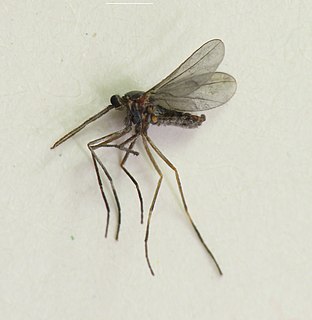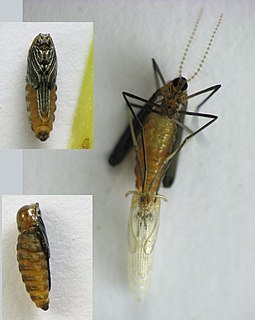
A midge is any small fly, including species in several families of non-mosquito Nematoceran Diptera. Midges are found on practically every land area outside permanently arid deserts and the frigid zones. Some midges, such as many Phlebotominae and Simuliidae, are vectors of various diseases. Many others play useful roles as prey for insectivores, such as various frogs and swallows. Others are important as detritivores, and form part of various nutrient cycles. The habits of midges vary greatly from species to species, though within any particular family, midges commonly have similar ecological roles.

Cecidomyiidae is a family of flies known as gall midges or gall gnats. As the name implies, the larvae of most gall midges feed within plant tissue, creating abnormal plant growths called galls. Cecidomyiidae are very fragile small insects usually only 2–3 mm (0.079–0.118 in) in length; many are less than 1 mm (0.039 in) long. They are characterised by hairy wings, unusual in the order Diptera, and have long antennae. Some Cecidomyiids are also known for the strange phenomenon of paedogenesis in which the larval stage reproduces without maturing first. In some species, the daughter larvae consume the mother, while in others, reproduction occurs later on in the egg or pupa.
Daphnephila truncicola is a species of gall midges first associated with stem galls on Lauraceae species, particularly Machilus thunbergii in Taiwan. Based on analysis on sequences of the mitochondrial cytochrome c oxidase subunit I, it has been suggested that in this genus, the stem-galling habit is a more ancestral state as opposed to the leaf-galling habit. This genus appears to have originated tropically and dispersed to Japan through Taiwan.

A gnat is any of many species of tiny flying insects in the dipterid suborder Nematocera, especially those in the families Mycetophilidae, Anisopodidae and Sciaridae. They can be both biting and non-biting. Most often they fly in large numbers, called clouds. "Gnat" is a loose descriptive category rather than a phylogenetic or other technical term, so there is no scientific consensus on what constitutes a gnat. Some entomologists consider only non-biting flies to be gnats. Certain universities and institutes also distinguish eye gnats: the Smithsonian Institution describes them as "non-biting flies, no bigger than a few grains of salt, ... attracted to fluids secreted by your eyes".
Schismatodiplosis is genus of flies in the family of gall midges Cecidomyiidae.

Asphondylia is a cosmopolitan genus of gall midges in the family Cecidomyiidae. All species in this genus induce galls on plants, especially on flowers and flower buds. There are over 300 described species in Asphondylia, with many more likely to be discovered and described, especially in the southern hemisphere. Within the genus, characteristics of the larvae and pupae are often most useful for distinguishing between species since adults of most species look very similar to one another. The species inducing a given gall can sometimes be identified based on the shape and placement of the gall in combination with the identity of the host plant.

Rhopalomyia is a genus of gall midges, insects in the family Cecidomyiidae. There are at least 267 described species in Rhopalomyia. Most species in this genus induce galls on plants in the Asteraceae. This genus has a cosmopolitan distribution. Rhopalomyia was first established by Ewald Heinrich Rübsaamen in 1892.
Catotricha americana is a species of basal gall midges in the family Cecidomyiidae. It is the type species of the genus and has only been confirmed to occur in New Hampshire. This species was first described by American entomologist Ephraim Porter Felt in 1908.
Catotricha is a genus of gall midges and wood midges in the family Cecidomyiidae. There are five described species in Catotricha.
Catotrichinae is a subfamily of Cecidomyiidae. The larvae feed on fungi. The following four genera are currently recognized along with the extinct genus Mesotrichoca:

Asteromyia is a genus of gall midges in the family Cecidomyiidae. There are about nine described species in Asteromyia.

Lasioptera is a genus of gall midges in the family Cecidomyiidae. There are at least 140 described species in Lasioptera.
Daphnephila is a genus of gall midge that appears in the Palearctic and Oriental biogeographic realms. Daphnephila species create leaf and stem galls on species of laurel plants, particularly in Machilus. Based on analysis on sequences of the mitochondrial cytochrome c oxidase subunit I, it has been suggested that in this genus, the stem-galling habit is a more ancestral state as opposed to the leaf-galling habit.
Anabremia is a genus of gall midge in the family Cecidomyiidae.
Trichoceromyia is a genus of midges in the family Cecidomyiidae. There is one described species in this genus: Trichoceromyia oregonensis. It is only known from Oregon.
Trichotoca is a genus of midges in the family Cecidomyiidae. There are two described species in this genus, both known only from Australia.
Wheeleriola is a genus of midges in the family Cecidomyiidae. The one described species in this genus - Wheeleriola perplexa - is known only from New Zeland.
Lestremiinae is a subfamily of Cecidomyiidae. It is composed of 105 described species classified into 13 genera. The larvae feed on fungi, primarily in rotting wood.
Allarete is a genus of midges in the family Cecidomyiidae. There are twelve described species in this genus. It is known from the holarctic, afrotropical, and oriental regions. The genus was first described by Arthur Earl Pritchard in 1951.
Allaretella is a genus of midges in the family Cecidomyiidae. Allartella germanica is the only described species in this genus. It has been recorded in Sweden, Latvia, Germany, and Austria. The genus was first described by Hans Meyer and Voldemars Spungis in 1994.






